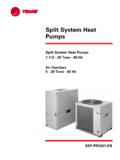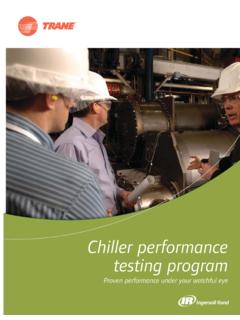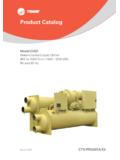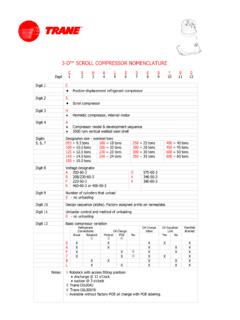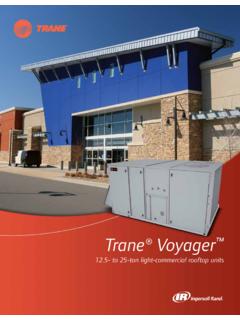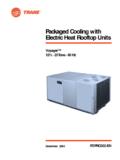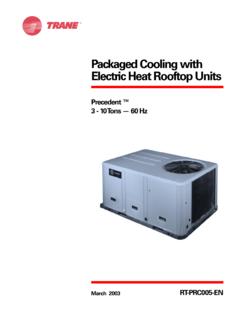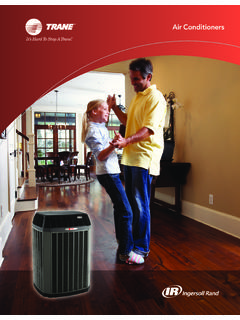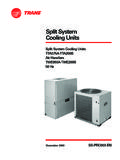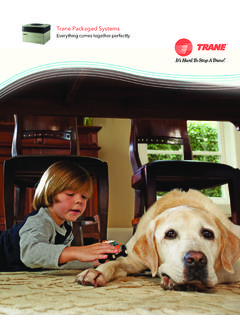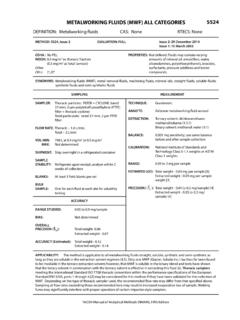Transcription of RTHD and RTAC - Trane
1 Service AlertRTHD and RTACC ontrol Operation, Setup and Troubleshooting for RTAC and RTHD Units with Tracer CH530 ControlsThe purpose of this bulletin is to provide control operation and general troubleshooting information on the RTAC Air Cooled Chillers and RTHD Water Cooled Chillers with the CH530 controls. It is recommended that the service technician be familiar with the CH530 operation prior to servicing the bulletin is intended to serve as a supplement to the RTAC and RTHD IOMs, the installation, operation and maintenance manuel. Subjects covered in this bulletin are intended to provide more comprehensive information for the RTAC and RTHD Troubleshooting RepairNovember 2005 RLC-SVD05A-ENWarnings and Cautions 2005 American Standard Inc. All rights reservedRLC-SVD05A-ENImportant - Read This First!This manual is intended for experienced service personnel familiar with the proper use of electrical diagnostic instruments and all personal safety procedures when working on live electrical Manual is not intended for individuals who have not been properly trained in handling live electrical Environmental Concerns!
2 Scientific research has shown that certain man-made chemicals can affect the earth s naturally occurring stratospheric ozone layer when released to the atmosphere. In particular, several of the identified chemicals that may affect the ozone layer are refrigerants that contain Chlorine, Fluorine and Carbon (CFCs) and those containing Hydrogen, Chlorine, Fluorine and Carbon (HCFCs). Not all refrigerants containing these compounds have the same potential impact to the environment. Trane advocates the responsible handling of all refrigerants including industry replacements for CFCs such as HCFCs and HFCs. Responsible Refrigerant Practices! Trane believes that responsible refrigerant practices are important to the environment, our customers, and the air conditioning industry. All technicians who handle refrigerants must be certified.
3 The Federal Clean Air Act (Section 608) sets forth the requirements for handling, reclaiming, recovering and recycling of certain refrigerants and the equipment that is used in these service procedures. In addition, some states or municipalities may have additional requirements that must also be adhered to for responsible management of refrigerants. Know the applicable laws and follow them. WARNING Contains Refrigerant!System contains oil and refrigerant under high pressure. Recover refrigerant to relieve pressure before opening the system. See unit nameplate for refrigerant type. Do not use non-approved refrigerants, refrigerant substitutes, or refrigerant to follow proper procedures or the use of non-approved refrigerants, refrigerant substitutes, or refrigerant additives could result in death or serious injury or equipment : Warnings and Cautions appear at appropriate sections throughout this literature.
4 Read these carefully. WARNING: Indicates a potentially hazardous situation which, if not avoided, could result in death or serious injury. CAUTION: Indicates a potentially hazardous situation which, if not avoided, may result in minor or moderate injury. It may also be used to alert against unsafe : Indicates a situation that may result in equipment or property-damage only Overview .. 5 Main Processor .. 5 Starter Module .. 5 Power Supply Module .. 5 LLIDs (Low Level Intelligent Devices) .. 5 IPC Overview and Troubleshooting .. 7 Installing a LLID .. 8 Bus connection crimping .. 8 Procedure for installing ..10 Troubleshooting problems with multiple LLIDS ..11 Power Supply ..14 Troubleshooting .. 14 Temperature Sensor ..16 Sensor Checkout Procedure .. 16Is the sensor bound and communicating?..16Is the sensor reading accurately?
5 17 Pressure Transducers .. 18 Transducer Checkout Procedure .. 18Is the transducer bound and communicating? .. 18Is the transducer reading accurately? ..19 Variable Speed Fan Control - RTAC Only .. 20 Startup and Operation.. 20 Inverter Fault Input .. 22 Troubleshooting the Inverter .. 22 Current Transformers .. 26CT and Starter Compressor Current Input Checkout Procedure .. 27 Over/Under Voltage .. 30 RTAC Chillers .. 30 Check out procedure for RTAC .. 30 Under/Over Voltage Transformer Checkout.. 30 RTHD Chillers .. 31 Check out procedure for RTHD .. 31 Potential Transformer .. 31 Starter Module.. 33 Starter .. 34X-Line .. 34Y-Delta .. 34 YDelta Starter Sequence .. 36 Solid State - RTHD Only .. 43 Compressor Capacity - RTHD .. 44 Checkout Procedure for the Load-Unload Outputs.. 44 Checkout procedure for the Slide Valve and Load-Unload Solenoids.
6 45 Load .. 47 Unload.. 47 Compressor Capacity - RTAC .. 48 Checkout Procedure for the Female Step Load Outputs .. 49 Checkout Procedure for the Step Load Solenoids Valve and Piston .. 49 Checkout Procedure for the Male Load-Unload Outputs .. 49 Checkout procedure for the Slide Valve and Load-Unload Solenoids .. 50 Contents4 RLC-SVD05A-ENContents Setup .. 50 Load .. 52 Unload.. 52 Electronic Expansion Valve .. 54 EXV Checkout Procedure .. 54Is the EXV bound and communicating?.. 54Is the EXV functioning properly?.. 55 Liquid Level Sensor .. 57 External LLID Sensor .. 57 Internal LLID .. 57 Liquid Level Sensor Checkout Procedure .. 57Is the sensor bound and communicating?.. 57Is the sensor reading accurately?.. 58 Gas Pump - RTHD Only .. 59 Gas Pump Checkout Procedure - Unit Off .. 59 Gas Pump Checkout Procedure - Unit On.
7 60 Optical Sensor - RTHD Only .. 61 Checkout Procedure .. 61 TechView Service Tool .. 62 Software Requirements .. 62 Hardware Requirements.. 62 Laptop requirements for CH530.. 63 The Download Process .. 63 Instructions for First Time Tracer CH530 Users.. 63 Using TechView .. 65 Downloading New Main Processor Software.. 67 Binding Process .. 67 Binding Symbols .. 70 Modify Chiller Configuration .. 70 RLC-SVX05A-EN5CH530 is a distributed architecture control that puts communication capability and some limited intelligence down at the sensor level (Low Level Intelligent Devices, or LLIDs). Higher level modules or Super LLIDs (starter) exist only as necessary to support system level control and communications where subsystems require a collection of I/O and primary benefit of the LLIDs architecture is the low cost of replacement parts.
8 CH530 architecture allows a single point to be replaced with only pig-tail wiring and electronics dedicated to a particular point. Main ProcessorThe main processor is the master of the chiller by collecting data, status, and diagnostic information and communicating commands to the other modules (starter) and the LLID bus. The communications bus is called the Inter-Processor Communications. The main processor is located in the human interfaces (DynaView, EZView). Starter ModuleThe starter module provides control of the compressor contactors when starting, running, and stopping the chiller. Starter types include Across the Line (RTAC), Y-Delta and Solid State (RTHD). The starter module provides protection of the compressor in the form of running overload, phase reversal, phase loss, phase imbalance, and momentary power Supply ModuleThe power supply module provides 24 VDC power to support all of the module and LLIDs (Low Level Intelligent Devices)The following devices are types of inputs and outputs that exist as LLIDs.
9 Some of the LLIDs are optional. The number and type of LLIDs are dependent on the unit size and configuration. temperature sensors low voltage binary inputs high voltage binary inputs analog input/output relay output triac outputCH530 Overview6 RLC-SVX05A-ENCH530 OverviewCH530 Overview EXV stepper driver liquid level sensor input inverter interface pressure transducerThe following is a graphic example of the CH530 1. CH530 RLC-SVB05A-EN7 The CH530 platform provides a highly modular approach for accommodating the inputs and outputs to control a chiller. The CH530 platform includes discrete devices for each input and output point on the system. For example, the EXV includes the electronics to drive its motor contained within the motor housing. The liquid level sensor includes the electronics necessary to read the float level.
10 Each temperature sensor includes the electronics to measure the thermistor value. The CH530 platform is very generic to varies chiller sizes or model applications. A four compressor design does not require a different module design than a two compressor design, nor did the two compressor design take on un-used components. An additional benefit to the LLID (low level intelligent device) approach is that parts stocking is greatly simplified. LLIDs of each type are not dedicated to a particular chiller design but can be applied individually across all sizes or models. In the typical installation, there are two sets of devices. One set of devices is installed in a control panel. This first set includes power supplies, devices that require customer wiring, and the main processor. Devices in the second set are installed at points of use around the unit and wired by stubs to a main trunk (IPC bus).
